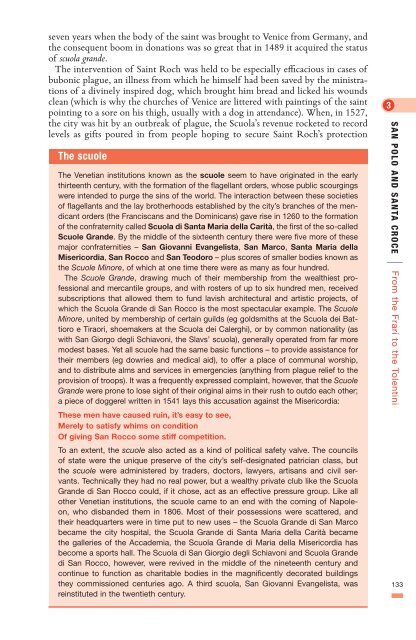Create successful ePaper yourself
Turn your PDF publications into a flip-book with our unique Google optimized e-Paper software.
seven years when <strong>the</strong> body of <strong>the</strong> saint was brought <strong>to</strong> <strong>Venice</strong> from Germany, <strong>and</strong><br />
<strong>the</strong> consequent boom in donations was so great that in 1489 it acquired <strong>the</strong> status<br />
of scuola gr<strong>and</strong>e.<br />
<strong>The</strong> intervention of Saint Roch was held <strong>to</strong> be especially efficacious in cases of<br />
bubonic plague, an illness from which he himself had been saved by <strong>the</strong> ministrations<br />
of a divinely inspired dog, which brought him bread <strong>and</strong> licked his wounds<br />
clean (which is why <strong>the</strong> churches of <strong>Venice</strong> are littered with paintings of <strong>the</strong> saint<br />
pointing <strong>to</strong> a sore on his thigh, usually with a dog in attendance). When, in 1527,<br />
<strong>the</strong> city was hit by an outbreak of plague, <strong>the</strong> Scuola’s revenue rocketed <strong>to</strong> record<br />
levels as gifts poured in from people hoping <strong>to</strong> secure Saint Roch’s protection<br />
<strong>The</strong> scuole<br />
<strong>The</strong> Venetian institutions known as <strong>the</strong> scuole seem <strong>to</strong> have originated in <strong>the</strong> early<br />
thirteenth century, with <strong>the</strong> formation of <strong>the</strong> flagellant orders, whose public scourgings<br />
were intended <strong>to</strong> purge <strong>the</strong> sins of <strong>the</strong> world. <strong>The</strong> interaction between <strong>the</strong>se societies<br />
of flagellants <strong>and</strong> <strong>the</strong> lay bro<strong>the</strong>rhoods established by <strong>the</strong> city’s branches of <strong>the</strong> mendicant<br />
orders (<strong>the</strong> Franciscans <strong>and</strong> <strong>the</strong> Dominicans) gave rise in 1260 <strong>to</strong> <strong>the</strong> formation<br />
of <strong>the</strong> confraternity called Scuola di Santa Maria della Carità, <strong>the</strong> first of <strong>the</strong> so-called<br />
Scuole Gr<strong>and</strong>e. By <strong>the</strong> middle of <strong>the</strong> sixteenth century <strong>the</strong>re were five more of <strong>the</strong>se<br />
major confraternities – San Giovanni Evangelista, San Marco, Santa Maria della<br />
Misericordia, San Rocco <strong>and</strong> San Teodoro – plus scores of smaller bodies known as<br />
<strong>the</strong> Scuole Minore, of which at one time <strong>the</strong>re were as many as four hundred.<br />
<strong>The</strong> Scuole Gr<strong>and</strong>e, drawing much of <strong>the</strong>ir membership from <strong>the</strong> wealthiest professional<br />
<strong>and</strong> mercantile groups, <strong>and</strong> with rosters of up <strong>to</strong> six hundred men, received<br />
subscriptions that allowed <strong>the</strong>m <strong>to</strong> fund lavish architectural <strong>and</strong> artistic projects, of<br />
which <strong>the</strong> Scuola Gr<strong>and</strong>e di San Rocco is <strong>the</strong> most spectacular example. <strong>The</strong> Scuole<br />
Minore, united by membership of certain guilds (eg goldsmiths at <strong>the</strong> Scuola dei Battioro<br />
e Tiraori, shoemakers at <strong>the</strong> Scuola dei Calerghi), or by common nationality (as<br />
with San Giorgo degli Schiavoni, <strong>the</strong> Slavs’ scuola), generally operated from far more<br />
modest bases. Yet all scuole had <strong>the</strong> same basic functions – <strong>to</strong> provide assistance for<br />
<strong>the</strong>ir members (eg dowries <strong>and</strong> medical aid), <strong>to</strong> offer a place of communal worship,<br />
<strong>and</strong> <strong>to</strong> distribute alms <strong>and</strong> services in emergencies (anything from plague relief <strong>to</strong> <strong>the</strong><br />
provision of troops). It was a frequently expressed complaint, however, that <strong>the</strong> Scuole<br />
Gr<strong>and</strong>e were prone <strong>to</strong> lose sight of <strong>the</strong>ir original aims in <strong>the</strong>ir rush <strong>to</strong> outdo each o<strong>the</strong>r;<br />
a piece of doggerel written in 1541 lays this accusation against <strong>the</strong> Misericordia:<br />
<strong>The</strong>se men have caused ruin, it’s easy <strong>to</strong> see,<br />
Merely <strong>to</strong> satisfy whims on condition<br />
Of giving San Rocco some stiff competition.<br />
To an extent, <strong>the</strong> scuole also acted as a kind of political safety valve. <strong>The</strong> councils<br />
of state were <strong>the</strong> unique preserve of <strong>the</strong> city’s self-designated patrician class, but<br />
<strong>the</strong> scuole were administered by traders, doc<strong>to</strong>rs, lawyers, artisans <strong>and</strong> civil servants.<br />
Technically <strong>the</strong>y had no real power, but a wealthy private club like <strong>the</strong> Scuola<br />
Gr<strong>and</strong>e di San Rocco could, if it chose, act as an effective pressure group. Like all<br />
o<strong>the</strong>r Venetian institutions, <strong>the</strong> scuole came <strong>to</strong> an end with <strong>the</strong> coming of Napoleon,<br />
who disb<strong>and</strong>ed <strong>the</strong>m in 1806. Most of <strong>the</strong>ir possessions were scattered, <strong>and</strong><br />
<strong>the</strong>ir headquarters were in time put <strong>to</strong> new uses – <strong>the</strong> Scuola Gr<strong>and</strong>e di San Marco<br />
became <strong>the</strong> city hospital, <strong>the</strong> Scuola Gr<strong>and</strong>e di Santa Maria della Carità became<br />
<strong>the</strong> galleries of <strong>the</strong> Accademia, <strong>the</strong> Scuola Gr<strong>and</strong>e di Maria della Misericordia has<br />
become a sports hall. <strong>The</strong> Scuola di San Giorgio degli Schiavoni <strong>and</strong> Scuola Gr<strong>and</strong>e<br />
di San Rocco, however, were revived in <strong>the</strong> middle of <strong>the</strong> nineteenth century <strong>and</strong><br />
continue <strong>to</strong> function as charitable bodies in <strong>the</strong> magnificently decorated buildings<br />
<strong>the</strong>y commissioned centuries ago. A third scuola, San Giovanni Evangelista, was<br />
reinstituted in <strong>the</strong> twentieth century.<br />
San Polo <strong>and</strong> Santa Croce<br />
|<br />
From <strong>the</strong> Frari <strong>to</strong> <strong>the</strong> Tolentini<br />
133







